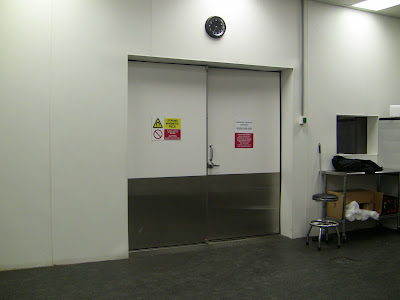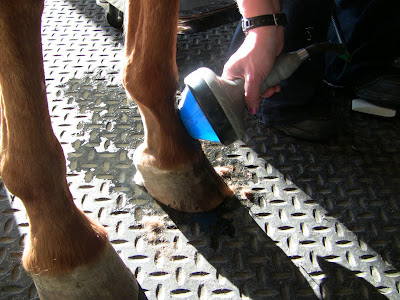Kaswyn has been on stall rest (plus handwalking) for the past month while his lateral collateral ligament in his left front leg heals. I've been hand-walking and grazing him every day, and he's out of his stall for 45 minutes to an hour. He's used to being out either during the day or all night in the summer, and it really sucks when the rest of the horses are out and he is cooped up in his stall. But, he needs to heal, so it's necessary.
I wasn't expecting to have Marge, the barn owner, approach me and ask me what my plans were for Kaswyn. Keep in mind that I've been friends with Marge for 18 years, and she knew Kaswyn as a 3 year old when I bought him. So not only do I have history with Marge, but my horse does too.
I told her that my plan was to get him sound and then ride him again. She said she really wanted to see me retire him. Her reasons -
He is 18
He has done everything that I have asked
He is a multi National Champion
He keeps injuring himself, which she thinks is from the work (but I think he does it in turnout)
His body is not built for dressage
It's time for me to just turn him out and let him be a horse, and if he gets hurt then it won't matter.
I've spent so much money already on his injuries.
Well.
I knew she felt this way, because she had hinted about it before, so I was not totally shocked to hear her say it. But this was the first time that she came right out and said "I want you to retire him." It was very direct, but that's the way that she is. I took a deep breath and explained why I wasn't going to just retire him from riding -
My plan is to ride him, because his injuries have not been career ending.
Three vets have said that it is not time to retire him.
He likely has arthritis, so not doing any work will actually make him stiff and be in more pain.
I have no goals for him, other than to keep sound and be ridden.
If, through our riding, he gets back in the show ring, then great. If he never gets there, at least I still get to ride him.
If I'm paying board every month, and he's ridable, I'd better be riding.
He loves to work, loves to be ridden, and loves to make me happy.
She agreed that some of these points were valid, but would be much happier if Kaswyn could get turned out. She didn't want to see him standing in a stall for the rest of his life. I told her that he'll be able to go out again eventually, when his leg is healed, and I brought up the round pen again.
Susan, Marge and I have all been searching for a round pen to use, with the plan of putting Kaswyn in a small round pen in one of the pastures so that he'd be out but couldn't run around and delay his healing (or hurt himself again). We have not been able to find an affordable one, so we've kept looking. I hadn't considered turning him out without one, but then Marge made a suggestion.
She asked if maybe Kaswyn could go out for an hour or so with Fire, his pasture buddy. At first I said no, I think it's too soon. Susan agreed, saying that Kaswyn would just run and that it would be a bad idea. We agreed to keep looking for a round pen and not do turnout at this time. But the more I thought about it, the more I thought that it might just work out, with some stipulations. I called my trainer and asked her, and she seemed to think that he'd be ok if he were monitored.
I called Marge and told her I'd like to try it, with a couple of conditions. Fire would have to be put out first, then Kaswyn would have to be walked over to the grass part of the pasture, with the chain over his nose, and allowed to settle down and graze. Then he could be unclipped from the lead rope and be free to be out for an hour, provided that he stays quiet. I'd do this for the first two times, staying for an hour to watch him. After that, he should get the routine and be fine with it. She said ok, and to let he know how it went.
I put fly spray on Kaswyn, so that the bugs would not make him crazy. Then I put Fire out in the pasture first, and went and got Kaswyn. He was pretty excited, and when we got to the first gate he was sure I was going to just turn him loose so he tried to take off. I had the chain on him, and had to stop him a few times. He pranced a bit as we got close to the second gate, which leads into the grass pasture. Again he thought it was time to get turned loose, but I hung onto him. Seconds later he had his head in the grass, just eating.
I waited for a minute or two, and when Fire was also settled down to graze I took the leadrope off of Kaswyn. For a minute he just grazed, but then he picked his head up and starting trotting a big circle.
My stomach sank. If he was going to trot around, or run, then this was not going to work. But he trotted one circle, did three canter strides, then stopped and ate. I watched them eat for ten minutes, then went back to the barn to clean some stalls.
I left them out for an hour, checking on them every five minutes. They did nothing but eat. Then I brought them back in to the barn without any issues. I repeated this the next day with no problems.
So it looks like Kaswyn's going to be able to go out on grass for an hour every day. Right now I'm allowed to ride him at the walk, and in 30 days I'm allowed to start riding him at the trot too. Probably 30 days after that I can canter, and I figure if I can canter him in the arena then he should be ok if he canters outside. As long as he's not running like a lunatic, he should be fine.
I know it's hard to find the balance of "a horse should be outside and be a horse" and "equine athletes need to be protected from hurting themselves and should not be turned out", but I'm always so much happier when my horse can be outside. Who says you can't have it both ways?
The Week In Pictures
5 years ago











